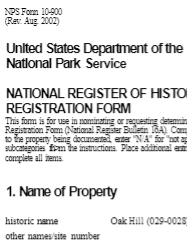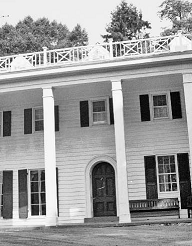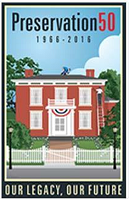Alert:

Oak Hill
Visit one of the oldest homes in Fairfax County with the Historic Oak Hill Open House on Saturday, Sept. 20, 2025, from 10 a.m. to 1 p.m. The home is located at 4716 Wakefield Chapel Road in Annandale.
Please note, Historic Oak Hill is a private residence and is only available for public access on September 20 from 10 a.m. to 1 p.m.
Tour participants are encouraged to carpool and utilize parking on the residential streets adjacent to Oak Hill.
In 2004, Seville Homes, the Northern Virginia Conservation Trust, the Fairfax County Park Authority and the Fairfax County Board of Supervisors agreed to a historic and conservation easement to preserve the privately-owned Oak Hill home and property, including its 200-year-old boxwoods. As part of the agreement, the owners may be asked to open the property and the first floor of the home periodically to share this important piece of county history. Since the property was saved, the community has been invited to visit the manse each year for home tours and outdoor displays celebrating local history and the environment.
In 2020 and 2021, the COVID-19 pandemic made it difficult to invite the public to the grounds.
To keep the tradition alive, residents, historians and government staff banded together to develop a virtual video tour of Oak Hill. The video was produced by Fairfax County Channel 16.
Congratulations to all the members of the team who ensured the story continues to be told and thanks to sponsors Northern Virginia Conservation Trust and the Fairfax County Park Foundation.
Oak Hill Virtual Tour Team: Oak Hill Homeowner Joe Braceland, Oak Hill Homeowner Laura Braceland, Cristin Bratt, John Browne, David Buchta, Liz Crowell, Diana Inthavong, Hanna Kras, Mary Lipsey, Roberta Longworth, Lindsey Martin, Mary Olien, Judy Pedersen, Alan Rowsome, Daniel Saltzberg, Ann Sharp, Margaret Thaxton, Aimee Vosper
In 2004, a historic and conservation easement was agreed to among Seville Homes, the Northern Virginia Conservation Trust, the Fairfax County Park Authority and the Fairfax County Board of Supervisors. The purpose of the easement was to historically preserve the privately-owned home and property, including its 200-year-old boxwoods. As part of the agreement, the owners may be requested to open the property and the first floor of the home periodically. The purchase of a historic easement on Oak Hill offers an opportunity to preserve an important piece of county history.
Built in 1790 by Richard Fitzhugh, Oak Hill was patterned after the rigid symmetry of the late Georgian style which was inspired by Italian Renaissance architecture. In 1830, an extension was added to the west Side of the original house. In the 1940s, renowned restoration architect Walter M. Macomber restored and remodeled the house in a Colonial Revival style. Other than the sunroom added to the west side in the 1970s, Oak Hill stands today as it did after the 1940s.
Oak Hill is privately owned by Laura and Joseph Braceland, who have called Oak Hill home since summer 2017. They are longtime Fairfax County residents. Their first home together was in Annandale, where their two children were born, and they have lived nearby ever since. Joe runs a local business, and Laura works at a nearby preschool and does freelance graphic design. Their children attended local schools. While Joe and Laura knew about historic Oak Hill, they never dreamed they would have a chance to live there until their opportunity to purchase it.
Virginia has always been part of their lives. Laura grew up with family in the National Park Service, and Joe was born a few miles away at Fairfax Hospital. They couldn't turn down the opportunity to live at Oak Hill, where people and events they had read about came together. They have said, "We're all thrilled to be part of a succession of residents through the centuries. At the same time, we feel a sense of home and belonging here. We're proud to be custodians of Virginia history and to partner with Fairfax County in preserving this unique and lovely part of the community for generations to come."
Oak Hill stands as a monument to history and a Fairfax County family.
In 1670, William Fitzhugh (a.k.a. William the Immigrant) settled in Westmoreland County, Virginia. He became a governor of the College of William and Mary and a member of the Virginia House of Burgesses. He also established one of the largest land grants in the new world. His land stretched from present day Stafford County to Arlington County. The Fairfax County portion of this property, 21,996 acres known as the Ravensworth Tract, was described in 1694 as "upon the runs of Accotinke, Mussel Creek run and on the south side of the run Four Mile Creek."
In the 1680s and 1690s, Ravensworth was marketed to French Huguenots who were suffering under religious persecution. In 1686, William Fitzhugh wrote the following to entice the Huguenots.
In 1730, tobacco warehouses were established at Little Hunting Creek and Occoquan. These helped make Ravensworth a prosperous tobacco plantation. By 1782, Ravensworth was the fourth largest plantation in Fairfax County and had 203 slaves. In 1783, the north section of the Ravensworth tract was divided among five male descendants of Fitzhugh. The south section, south of Braddock Road, remained largely intact until Robert E. Lee inherited it. Richard Fitzhugh, one of the five [great] grandsons, built Oak Hill in 1790. That same year, Ossian Hall and another house named Dover were built by Fitzhugh’s descendants.
Oak Hill is the only home built by the Fitzhugh family left in Fairfax County.
Ravensworth was the largest and best known of the three mansions built on the large Ravensworth land grant. William Fitzhugh (1741-1809), a great grandson of "William, the Immigrant," built the manor house circa 1796 on his inherited 12,000 acres. When he died in 1809, the property passed to his son William Henry and, upon the son's death in 1830, to William Henry's childless widow Anna Maria Sarah (Goldsborough) Fitzhugh. Without a direct heir, Anna Maria received the property for her lifetime in trust for William Henry's niece, Mary Custis Lee, and her heirs.
Anna Maria managed the estate through the difficult years of the Civil War until her death in 1874. The property, reduced by sales to 8,300 acres, was then divided among the five living Lee children, Mary Custis Lee having died in 1873.
Mary Custis Lee was the wife of Confederate General Robert E. Lee. They married when he was a lieutenant. Mary’s mother was Mary Lee Fitzhugh, and her father George Washington Parke Custis of Arlington House was the grandson of Martha Washington, wife of the nation’s first president.
In 1874, Confederate General William Henry Fitzhugh "Rooney" Lee – the son of Robert E. and Mary Custis Lee -- inherited the Ravensworth manor house and 502 acres. He lived there from 1874 until his death in 1891. The house burned August 1, 1926. The Lee Family rebuilt a farm house on the same foundation, and it remained there until the land was sold for development in 1957.
Ossian Hall was built by Nicholas Fitzhugh c.1783 on the Ravensworth land grant. In 1804, Dr. David Stuart, a commissioner for the Federal City, purchased Ossian Hall and moved there with his wife, Eleanor Calvert Custis Stuart, and their children. Joseph L. Bristow, a midwestern politician, purchased Ossian Hall in 1918 and died there on July 14, 1944. On September 3, 1959, Ossian Hall was burned as a training exercise for the Annandale Fire Department.



